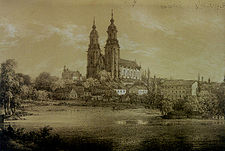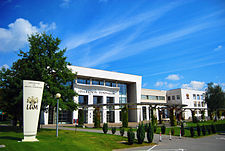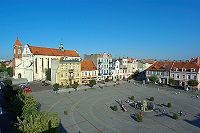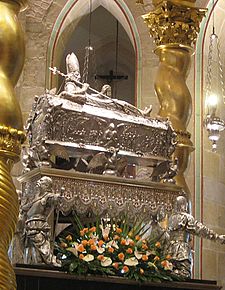
Gniezno
Gniezno (German: Gnesen) is a city in central-western Poland, some 50 km east of Poznań, inhabited by about 70,000 people. One of the Piasts' chief cities, it was mentioned by 10th century A.D. sources as the capital of Piast Poland (in Dagome Iudex) however the first capital of Piast realm was most likely Giecz built around 840s A.D. Its Roman Catholic archbishop, the Archbishop of Gniezno, is the Primate of Poland. These historical facts make its position in Polish history similar to Canterbury or Rheims.
Gniezno is located in the Greater Poland Voivodeship (since 1999), previously in Poznań Voivodeship. The city is the administrative capital of the Gniezno County (powiat). There are archaeological traces of human settlement since the late Paleolithic. Early Slavonic settlements on the Lech Hill and the Maiden Hill are dated to 8th century. At the beginning of the 10th century this was the site of several places sacred to the Slavic religion. The ducal stronghold was founded just before AD 940 on the Lech Hill, and surrounded with some fortified suburbs and open settlements.
There are archaeological traces of human settlement since the late Paleolithic. Early Slavonic settlements on the Lech Hill and the Maiden Hill are dated to 8th century. At the beginning of the 10th century this was the site of several places sacred to the Slavic religion. The ducal stronghold was founded just before AD 940 on the Lech Hill, and surrounded with some fortified suburbs and open settlements.
Legend of Lech, Czech and Rus
According to the Polish version of legends: three brothers Lech, Czech and Rus were exploring the wilderness to find a place to settle. Suddenly they saw a hill with an old oak and an eagle on top. Lech said: this white eagle I will adopt as an emblem of my people, and around this oak I will build my stronghold, and because of the eagle nest [Polish: gniazdo]. I will call it Gniezdno [modern: Gniezno]. The other brothers went further on to find a place for their people. Czech went to the South (to found the Czech Lands) and Rus went to the East (to create Rus' (region).
Cradle of the Polish state
Around 940 AD Gniezno, being an important pagan cult center, became one of the main fortresses of the early Piast rulers, along with aforementioned fortresses at Giecz, Kruszwica, Poznań, Kalisz, Łęczyca, Ostrów Lednicki, Płock, Włocławek others. Mieszko I might have moved the capital to Gniezno from Poznań after his own and his realm's baptism, but actual move of the capital to Gniezno might have coincided with a growing German menace of the late 10th century and early 11th century depositing the remains of Saint Adalbert in a newly built church, to underline Gniezno's importance as the religious centre and capital of Bolesław I Chrobry's kingdom.

In the next centuries Gniezno evolved as a regional seat of the eastern part of Greater Poland, and in 1238 municipal autonomy was granted by the duke Władysław Odonic. Gniezno was again the coronation site in 1295 and 1300.
The city was destroyed again by the Teutonic Knights' invasion in 1331, and after an administrative reform became a county within the Kalisz Voivodeship (since the 14th century till 1768). Gniezno was hit by heavy fires in 1515, 1613, was destroyed during the Swedish invasion wars of the 17th-18th centuries and by a plague in 1708-1710. All this caused depopulation and economic decline, but the city was soon revived during the 18th century to become the Gniezno Voivodeship in 1768.
Prussia

Gniezno was annexed by the Kingdom of Prussia in the 1793 Second Partition of Poland and became part of the province of South Prussia. During the Kościuszko Uprising Polish army under general Jan Henryk Dąbrowski liberated the town in September 1794 and defeated a Prussian Army north of Gniezno near Łabiszyn. During the Napoleonic Wars an uprising against Prussian rule happened. French appeared in Gniezno in November 1806, and following general Jan Henryk Dabrowski's order issued to all town and cities and country property owners to provide recruits for the organizing Polish forces, Gniezno initially provided 60 recruits who participated in the battles of 1806-07. Consequently the town was included within the Duchy of Warsaw, but upon defeat of Napoleon in Russian in 1812 was occupied by the Russian army and was returned to Prussia in the 1815 Congress of Vienna. Gniezno was subsequently governed within Kreis Gnesen of the Grand Duchy of Posen and the later Province of Posen. Following the Greater Poland Uprising (1918–1919) and the Treaty of Versailles Gniezno became part of the Second Polish Republic. Its citizen-soldiers joined the Polish army fighting the Bolsheviks during the Polish–Soviet War.
World War II
Gniezno was annexed into Nazi Germany on 26 October 1939 after the invasion of Poland and made part of Reichsgau Wartheland. The town was occupied by the Red Army in January 1945 and restored to Poland.
Archbishop of Gniezno
Gniezno's Roman Catholic archbishop is traditionally the Primate of Poland (Prymas Polski). After the partitions of Poland the see was often combined with others, first with Poznań and then with Warsaw. In 1992 Pope John Paul II reorganized the Polish hierarchy and the city once again had a separate bishop. Cardinal Józef Glemp, who had been archbishop of Gniezno and Warsaw and retained Warsaw, was designated to remain Primate until his retirement, but afterward the Archbishop of Gniezno, at present Henryk Muszyński, would again be Primate of Poland.

WWW: gniezno.eu
Adress:
Miejski Ośrodek Kultury w Gnieźnie
ul. Łubieńskiego 11
62-200 Gniezno






.jpg&width=156&height=69&cache_dir=cache)
.jpg&width=156&height=69&cache_dir=cache)

.jpg&width=156&height=69&cache_dir=cache)













